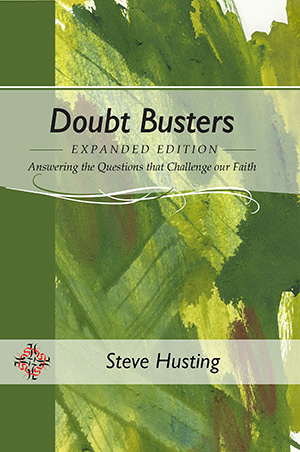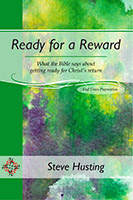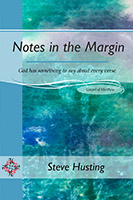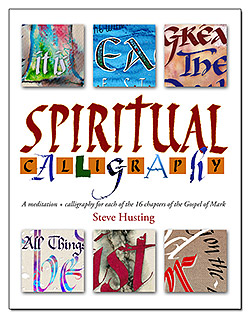Revelation chapter 12 is usually called by teachers and commentators a break, pause, or flashback as we jump back in time to the Satanic persecution of the Jews and the birth of Christ. But Jesus protects us from that thinking by dividing the book into three parts when He gave direction to John in Revelation 1:19: “Write the things which you have seen, and the things which are, and the things which will take place after this.”
With these words, Jesus divides Revelation into “the things which you [John] have seen,” which is the vision of Jesus in chapter one; “the things which are,” which refers to chapters 2-3, and “the things which will take place after this,” which is chapters 4-22. (Note that 4:1 begins with, “I will show you what must take place after this,” which begins the third section of the book.) So there’s no room in the three divisions for the past. We can’t place Revelation 12 before John’s vision of Christ.
Revelation 12 could take place before John’s encounter if Jesus had said, “Write the things which you have seen, and the things which are, and the things which will take place after this, and the things before My visit to you, and the things which will take place after this.” But that would be pointless, wouldn’t it? It pretty well sums up all of history past and all of the future. If He meant this, Jesus might as well have said succinctly, “Write the things that take place in the past, present, and future.” But then why bother to say it at all? By eliminating the times before His encounter with John, Jesus places the bulk of events of Revelation where they belong, each part in its own time. With this reasoning, there is no room for the past in the whole of Revelation.
How then are we to understand chapter 12 if it does not pertain to the Jews in the past? This article is an attempt to let the Bible interpret the passage for itself. I can’t explain everything, simply because it takes place in the future using symbolic figures that will make sense in its own time. The ideas that follow are not necessarily the best ideas; they may even be wrong. But I have the freedom to explore and think for myself about how the Bible harmonizes with itself.
12:1-2
There is no symbolism of a woman with stars on her head in the OT. A woman with the moon under her feet does not appear in the OT. A woman clothed with the sun is not in the OT. Israel is never represented in these ways in the OT.
But there is a woman like this, a heavenly woman who gives birth, in the NT: “but the Jerusalem above is free, which is the mother of us all” (Galatians 4:26). With his epistle to the Galatians, Paul is afraid the church is moving away from faith to law. To help them understand the benefits of faith verses the disadvantages of living according to the law, Paul introduces two women who prefigure these two states: the bondwoman and the freewoman (Galatians 4:21-31). There, the heavenly woman represents a new covenant of faith, as opposed to the bondwoman Hagar who represents the old covenant on Mount Sinai. The heavenly woman gives birth to the children of promise, people who are trustin gin God. The bondwoman gives birth to people who follow laws, while the new covenant children live by faith. These latter “are not children of the bondwoman, but of the free.”
This heavenly woman imagery is of the church age, and they are composed of people of faith within the church who are living by the Spirit, while the earthly woman represents people who are living after the flesh.
The heavenly woman, representing the new covenant, is giving birth to a heavenly minded people who live by faith, who have their hearts set on a heavenly home, not on the earth (Hebrews 11:13-16).
12:5
The heavenly woman bears a male child who will rule all nations with a rod of iron. Jesus is portrayed as someone who will rule with a rod of iron in Revelation 19:15. However, some individuals in the church will rule with rods of iron (meaning strict discipline), as Jesus promises in Revelation 2:26-28: “And he who overcomes, and keeps My works until the end, to him I will give power over the nations–‘He shall rule them with a rod of iron; They shall be dashed to pieces like the potter’s vessels’–as I also have received from My Father; and I will give him the morning star.”
This rule is promised to those in the church who overcome the negatives Jesus brought up concerning that church. Jesus makes a difference between groups in the church — those who overcome and those who don’t.
As soon as this woman gives birth to a suffering people of faith, the male child is caught up to the throne. This sounds like the Rapture, which Jesus says in Luke 21:34-36 is for those who are counted worthy. Many think a 7-year tribulation period starts at that point. “The beginning of sorrows” starts, according to the parallel account in Matthew 24:8.
Some church leaders think the rapture is for the whole church; Chuck Smith in his book The Final Act believes the Rapture is only for those who are ready, and the rest will be left behind. His book gives scriptures in defense of this view. Those who take their faith seriously, overcoming sin, are ready. The rest of this Revelation 12 chapter concerns those of the church who are left behind.
The rest of the imagery in Revelation 12 is difficult, pertaining to events in the future, so I can’t nail them down with specifics. It’s possible they link to prophecies in the OT, but the Lord has not opened my eyes to such connections at this time.
12:6
The new covenant influence is not completely lost, but nourishes those who in shock realize that they were left behind. “We’ve been left behind! Where did we go wrong?” They learn to turn from trusting in their works to living by faith in their new hostile environment. There will be revival here. (Some have the idea that when the Church leaves, the Holy Spirit will leave and will no longer work on earth. Obviously, with only part of the church gone, the Holy Spirit will still continue to work.)
We are not told who “they” are who feed her. Are these people who are protected in various places and compassionate people bring food and clothing to them? (For this, see the sheep on Christ’s right hand in Matthew 25:34-40.)
12:7-13
Perhaps this is when Satan enters the Antichrist figure and persecutes the church and Jews. If so, this could be the 5th seal period of Revelation 6:9-11, in which they are martyred for their faith (and parallels Matthew 24:8-10). Some in the church who were left behind finally return to a life of faith and have the courage to die during the Antichrist’s persecution: “And they overcame him by the blood of the Lamb and by the word of their testimony, and they did not love their lives to the death” (Revelation 12:11). They “overcame” him by holding to the faith until death; they did not give in to “the great dragon’s” lies and threats.
So those who are ready, who are worthy for the first rapture, are already giving their lives to live for Jesus. They have proved their faith by their works of love for Him.
(Don’t be alarmed by my jumping around Revelation with chapters out of order, putting two events together than are chapters apart. The seals in chapter 5, for instance, are an encapsulated overview of the future, and individual chapters after that focus on specifics, but not always in order by chapter.)
12:14-17
I can’t explain this portion of scripture. Perhaps the newly heavenly minded people are protected for 3.5 years from the future Antichrist’s persecution in various ways. They finally “keep the testimony of Jesus Christ” and prove it by dying for their faith as I mentioned above. These could include Jews who come to faith during this time. These verses sound like the persecution of the 5th seal in chapter 6, and the sealing of the Jews in chapter 7.
The following gives an overview of events afterward.
1. After 12:14-17 above, the cosmic disturbances of the 6th seal appear (Revelation 6:12-16, which parallels Matthew 24:14-31).
2. Then we get the first statement made of the wrath of God in Revelation 6:17.
3. At which point the rapture of Revelation 7:9-17 occurs, in which “we who are alive and remain [that is, those in Revelation 12 who were left behind] shall be caught up” (1 Thessalonians 4:17a). We are not appointed to this wrath (1 Thessalonians 5:9), so we are taken out immediately before God’s wrath is poured out. Note the parallel sequence in 2 Thessalonians 1:4-9, in which the Lord comes while the church is persecuted; first persecution, then rapture. From this point, the Lord probably circles the globe with His angels, executing a prolonged judgment for the next 3.5 years.
4. The wrath of God is poured out on the unbelieving world. The trumpet wrath is emptied in Rev. 8-9. The two witnesses are taken up in Rev. 11 and the 7th trumpet is blown. The bowls of wrath of Rev. 15-16 are poured out. The fall of Babylon takes place in Rev. 18-19. Then Satan’s army is quickly defeated and dispatched.
(If you are intrigued by the idea of a rapture in the middle of the tribulation, I recommend reading The Sign by Robert Van Kampen and The Pre-wrath Rapture of the Church by Marvin Rosenthal. Please don’t be afraid to read of opposing points of view. They may change your mind or confirm your present views.)




